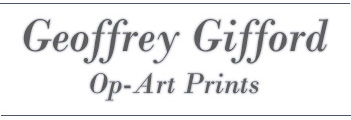




















Expanding on the work of the 1960s optical art (op art) movement, Australian artist Geoffrey Gifford is at the forefront of a new wave of exploration.
The two main proponents of op art, British artist Bridget Riley and the Hungarian, Victor Vasarely, worked on the psychology of perception, challenging the viewer and questioning what we see. In this new work, Gifford demonstrates his mastery of a visual rule book that extends back even further, to the start of the twentieth century, using a visual language informed by artists such as Kazimir Malevich, the Russian creator of Suprematism. Malevich's movement laid the foundations for many modern art movements that would follow. We see this language in Gifford's work, discreetly articulated in geometric overlays that seek to bring order and concentrate the eye.
Like all good artists Gifford understands the artistic traditions that went before, and then sets out to say something new. While these works are digital, the quality of the prints extends beyond the capacity of the computer screen to display them.
These works provide us with a conundrum - their visual complexity makes them delicious to the eye but difficult to look into. That's an exciting proposition!
Gifford's work encompasses painting, sculptural installation, and digital printmaking. He maintained a studio practice for many years in the USA and is currently based in Sydney.
Stephen Richardson - SoHo MUSEUM
Copyright ©1996 SoHoMUSEUM.com
All rights reserved. Do not duplicate or redistribute in any form.
|